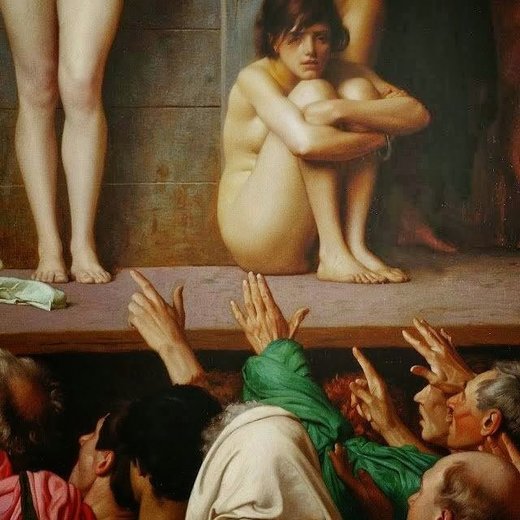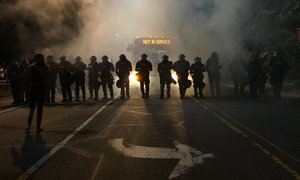Secret History
They came as slaves: human cargo transported on British ships bound for the Americas. They were shipped by thehundreds of thousands and included men, women, and even the youngest of children.
Whenever they rebelled or even disobeyed an order, they were punished in the harshest ways. Slave owners would hang their human property by their hands and set their hands or feet on fire as one form of punishment. Some were burned alive and had their heads placed on pikes in the marketplace as a warning to other captives.
We don't really need to go through all of the gory details, do we? We know all too well the atrocities of the African slave trade.
But are we talking about African slavery? King James VI and Charles I also led a continued effort to enslave the Irish. Britain's Oliver Cromwell furthered this practice of dehumanizing one's next door neighbor.
The Irish slave trade began when James VI sold 30,000 Irish prisoners as slaves to the New World. His Proclamation of 1625 required Irish political prisoners be sent overseas and sold to English settlers in the West Indies.
By the mid 1600s, the Irish were the main slaves sold to Antigua and Montserrat. At that time, 70% of the total population of Montserrat were Irish slaves.
Ireland quickly became the biggest source of human livestock for English merchants. The majority of the early slaves to the New World were actually white.
From 1641 to 1652, over 500,000 Irish were killed by the English and another 300,000 were sold as slaves. Ireland's population fell from about 1,500,000 to 600,000 in one single decade.
Families were ripped apart as the British did not allow Irish dads to take their wives and children with them across the Atlantic. This led to a helpless population of homeless women and children. Britain's solution was to auction them off as well.
During the 1650s, over 100,000 Irish children between the ages of 10 and 14 were taken from their parents and sold as slaves in the West Indies, Virginia and New England. In this decade, 52,000 Irish (mostly women and children) were sold to Barbados and Virginia.
Another 30,000 Irish men and women were also transported and sold to the highest bidder. In 1656, Cromwell ordered that 2000 Irish children be taken to Jamaica and sold as slaves to English settlers.
Many people today will avoid calling the Irish slaves what they truly were: Slaves. They'll come up with terms like "Indentured Servants" to describe what occurred to the Irish.However, in most cases from the 17th and 18th centuries, Irish slaves were nothing more than human cattle.
As an example, the African slave trade was just beginning during this same period. It is well recorded that African slaves, not tainted with the stain of the hated Catholic theology and more expensive to purchase, were often treated far better than their Irish counterparts.
African slaves were very expensive during the late 1600s (£50 Sterling). Irish slaves came cheap (no more than £5 Sterling). If a planter whipped, branded or beat an Irish slave to death, it was never a crime. A death was a monetary setback, but far cheaper than killing a more expensive African.
The English masters quickly began breeding the Irish women for both their own personal pleasure and for greater profit. Children of slaves were themselves slaves, which increased the size of the master's free workforce.
Even if an Irish woman somehow obtained her freedom, her kids would remain slaves of her master. Thus, Irish mothers, even with this new found emancipation, would seldom abandon their children and would remain in servitude.
In time, the English thought of a better way to use these women to increase their market share: The settlers began to breed Irish women and girls (many as young as 12) with African men to produce slaves with a distinct complexion. These new "mulatto" slaves brought a higher price than Irish livestock and, likewise, enabled the settlers to save money rather than purchase new African slaves.
This practice of interbreeding Irish females with African men went on for several decades and was so widespread that, in 1681, legislation was passed "forbidding the practice of mating Irish slave women to African slave men for the purpose of producing slaves for sale."In short, it was stopped only because it interfered with the profits of a large slave transport company.
England continued to ship tens of thousands of Irish slaves for more than a century. Records state that, after the 1798 Irish Rebellion, thousands of Irish slaves were sold to both America and Australia. There were horrible abuses of both African and Irish captives. One British ship even dumped 1,302 slaves into the Atlantic Ocean so that the crew would have plenty of food to eat.
There is little question the Irish experienced the horrors of slavery as much (if not more, in the 17th Century) as the Africans did. There is also little question that those brown, tanned faces you witness in your travels to the West Indies are very likely a combination of African and Irish ancestry.
In 1839, Britain finally decided on it's own to end its participation in Satan's highway to hell and stopped transporting slaves. While their decision did not stop pirates from doing what they desired, the new law slowly concluded this chapter of Irish misery.
But, if anyone, black or white, believes that slavery was only an African experience, then they've got it completely wrong. Irish slavery is a subject worth remembering, not erasing from our memories.
But, why is it so seldom discussed? Do the memories of hundreds of thousands of Irish victims not merit more than a mention from an unknown writer?
Or is their story to be the one that their English masters intended: To completely disappear as if it never happened.
None of the Irish victims ever made it back to their homeland to describe their ordeal. These are the lost slaves; the ones that time and biased history books conveniently forgot.
Interesting historical note: the last person killed at the Salem Witch Trials was Ann Glover. She and her husband had been shipped to Barbados as a slave in the 1650's. Her husband was killed there for refusing to renounce Catholicism.
In the 1680's she was working as a housekeeper in Salem. After some of the children she was caring for got sick she was accused of being a witch.
At the trial they demanded she say the Lord's Prayer. She did so, but in Gaelic, because she didn't know English. She was then hung.
To learn more you can go to the following sources:
Political Education Committee (PEC)
American Ireland Education Foundation
54 South Liberty Drive, Suite 401
Stony Point NY 10980
Whenever they rebelled or even disobeyed an order, they were punished in the harshest ways. Slave owners would hang their human property by their hands and set their hands or feet on fire as one form of punishment. Some were burned alive and had their heads placed on pikes in the marketplace as a warning to other captives.
We don't really need to go through all of the gory details, do we? We know all too well the atrocities of the African slave trade.
But are we talking about African slavery? King James VI and Charles I also led a continued effort to enslave the Irish. Britain's Oliver Cromwell furthered this practice of dehumanizing one's next door neighbor.
The Irish slave trade began when James VI sold 30,000 Irish prisoners as slaves to the New World. His Proclamation of 1625 required Irish political prisoners be sent overseas and sold to English settlers in the West Indies.
By the mid 1600s, the Irish were the main slaves sold to Antigua and Montserrat. At that time, 70% of the total population of Montserrat were Irish slaves.
Ireland quickly became the biggest source of human livestock for English merchants. The majority of the early slaves to the New World were actually white.
From 1641 to 1652, over 500,000 Irish were killed by the English and another 300,000 were sold as slaves. Ireland's population fell from about 1,500,000 to 600,000 in one single decade.
Families were ripped apart as the British did not allow Irish dads to take their wives and children with them across the Atlantic. This led to a helpless population of homeless women and children. Britain's solution was to auction them off as well.
During the 1650s, over 100,000 Irish children between the ages of 10 and 14 were taken from their parents and sold as slaves in the West Indies, Virginia and New England. In this decade, 52,000 Irish (mostly women and children) were sold to Barbados and Virginia.
Another 30,000 Irish men and women were also transported and sold to the highest bidder. In 1656, Cromwell ordered that 2000 Irish children be taken to Jamaica and sold as slaves to English settlers.
Many people today will avoid calling the Irish slaves what they truly were: Slaves. They'll come up with terms like "Indentured Servants" to describe what occurred to the Irish.However, in most cases from the 17th and 18th centuries, Irish slaves were nothing more than human cattle.
As an example, the African slave trade was just beginning during this same period. It is well recorded that African slaves, not tainted with the stain of the hated Catholic theology and more expensive to purchase, were often treated far better than their Irish counterparts.
African slaves were very expensive during the late 1600s (£50 Sterling). Irish slaves came cheap (no more than £5 Sterling). If a planter whipped, branded or beat an Irish slave to death, it was never a crime. A death was a monetary setback, but far cheaper than killing a more expensive African.
The English masters quickly began breeding the Irish women for both their own personal pleasure and for greater profit. Children of slaves were themselves slaves, which increased the size of the master's free workforce.
Even if an Irish woman somehow obtained her freedom, her kids would remain slaves of her master. Thus, Irish mothers, even with this new found emancipation, would seldom abandon their children and would remain in servitude.
In time, the English thought of a better way to use these women to increase their market share: The settlers began to breed Irish women and girls (many as young as 12) with African men to produce slaves with a distinct complexion. These new "mulatto" slaves brought a higher price than Irish livestock and, likewise, enabled the settlers to save money rather than purchase new African slaves.
This practice of interbreeding Irish females with African men went on for several decades and was so widespread that, in 1681, legislation was passed "forbidding the practice of mating Irish slave women to African slave men for the purpose of producing slaves for sale."In short, it was stopped only because it interfered with the profits of a large slave transport company.
England continued to ship tens of thousands of Irish slaves for more than a century. Records state that, after the 1798 Irish Rebellion, thousands of Irish slaves were sold to both America and Australia. There were horrible abuses of both African and Irish captives. One British ship even dumped 1,302 slaves into the Atlantic Ocean so that the crew would have plenty of food to eat.
There is little question the Irish experienced the horrors of slavery as much (if not more, in the 17th Century) as the Africans did. There is also little question that those brown, tanned faces you witness in your travels to the West Indies are very likely a combination of African and Irish ancestry.
In 1839, Britain finally decided on it's own to end its participation in Satan's highway to hell and stopped transporting slaves. While their decision did not stop pirates from doing what they desired, the new law slowly concluded this chapter of Irish misery.
But, if anyone, black or white, believes that slavery was only an African experience, then they've got it completely wrong. Irish slavery is a subject worth remembering, not erasing from our memories.
But, why is it so seldom discussed? Do the memories of hundreds of thousands of Irish victims not merit more than a mention from an unknown writer?
Or is their story to be the one that their English masters intended: To completely disappear as if it never happened.
None of the Irish victims ever made it back to their homeland to describe their ordeal. These are the lost slaves; the ones that time and biased history books conveniently forgot.
Interesting historical note: the last person killed at the Salem Witch Trials was Ann Glover. She and her husband had been shipped to Barbados as a slave in the 1650's. Her husband was killed there for refusing to renounce Catholicism.
In the 1680's she was working as a housekeeper in Salem. After some of the children she was caring for got sick she was accused of being a witch.
At the trial they demanded she say the Lord's Prayer. She did so, but in Gaelic, because she didn't know English. She was then hung.
To learn more you can go to the following sources:
Political Education Committee (PEC)
American Ireland Education Foundation
54 South Liberty Drive, Suite 401
Stony Point NY 10980
Reader Comments
Well
I have Irish heritage on both sides of my family, it was never really disclosed to me as a child, it was never talked about, My families on both sides emigrated to the UK in the late 1800'S.
And given the prejudice against the Irish at that time and such defamatory names could any one wonder why I was never told. This continued even mid 20th century, the jokes about the Irish navy (manual worker) and many more derogatory terms and jokes used. This of course propagated during the conflict in Northern Ireland, where my Irish heritage comes from.
Trying to piece that heritage, and why they left, is lost to me, the family members that had that knowledge are dead. I can only come to the conclusion, that they didn't want me to suffer as they had.
Another lesson of history, mass genocide of a nation and history written
by the victors.
And given the prejudice against the Irish at that time and such defamatory names could any one wonder why I was never told. This continued even mid 20th century, the jokes about the Irish navy (manual worker) and many more derogatory terms and jokes used. This of course propagated during the conflict in Northern Ireland, where my Irish heritage comes from.
Trying to piece that heritage, and why they left, is lost to me, the family members that had that knowledge are dead. I can only come to the conclusion, that they didn't want me to suffer as they had.
Another lesson of history, mass genocide of a nation and history written
by the victors.
well we do when they are black, we get an endless stream of guilt laden articles and movies to remind us everyday how the white man is the devil.
Is it any wonder why so many blacks have this huge chip on their shoulders and act like victims?
p.s. AND the best part is the first time i ever heard about how the Irish were treated was from a black guy....really fucking smart dude, i learned a lot from him.
So why make this stupid post, that doesn't make any coherent sense.
I don't get your comment either. Are you basically just wanting to have a dig at black people, as if they get too much limelight in your view and you don't get any?
The victims have far more in common than the 1% who rule over them.
The victims have far more in common than the 1% who rule over them.
Even when the gory details are not about non-whites, we see that certain people are so sensitive that they use indirectly related topics to remind people how sensitive they are. It's important than non-sensitives watch this video on white fragility to know how to avoid triggering sensitives:
[Link]
[Link]
White Cargo: The Forgotten History of Britain's White Slaves in America by Don Jordan 4.5 out of 5 stars
This vividly written book tells the tale from both sides of the Atlantic . . . meticulously sourced and footnoted—but is never dry or academic...Jordan and Walsh offer an explanation of how the structures of slavery—black or white—were entwined in the roots of American society. They refrain from drawing links to today, except to remind readers that there are probably tens of millions of Americans who are descended from white slaves without even knowing it. Amazon: [Link]
They Were White and They Were Slaves: The Untold History of the Enslavement of Whites in Early America by Michael Hoffman 3.8 out of 5 stars
They Were White and They Were Slaves is a thoroughly researched challenge to the conventional historiography of colonial and industrial labor, a stunning journey into a hidden epoch, the slave trade of Whites, hundreds of thousands of whom were kidnapped, chained, whipped and worked to death in the American colonies and during the Industrial Revolution. This is a chronicle that has never been fully told, part of a vital heritage that has until now comprised the dustiest shelf in the darkest corner of suppressed history. Amazon: [Link]
Also ...
The Irish Slaves: Slavery, Indenture and Contract Labor Among Irish…
Rhetta Akamatsu 3.9 out of 5 stars
To Hell or Barbados: The Ethnic Cleansing of Ireland
Sean O'Callaghan 4.4 out of 5 stars
This vividly written book tells the tale from both sides of the Atlantic . . . meticulously sourced and footnoted—but is never dry or academic...Jordan and Walsh offer an explanation of how the structures of slavery—black or white—were entwined in the roots of American society. They refrain from drawing links to today, except to remind readers that there are probably tens of millions of Americans who are descended from white slaves without even knowing it. Amazon: [Link]
They Were White and They Were Slaves: The Untold History of the Enslavement of Whites in Early America by Michael Hoffman 3.8 out of 5 stars
They Were White and They Were Slaves is a thoroughly researched challenge to the conventional historiography of colonial and industrial labor, a stunning journey into a hidden epoch, the slave trade of Whites, hundreds of thousands of whom were kidnapped, chained, whipped and worked to death in the American colonies and during the Industrial Revolution. This is a chronicle that has never been fully told, part of a vital heritage that has until now comprised the dustiest shelf in the darkest corner of suppressed history. Amazon: [Link]
Also ...
The Irish Slaves: Slavery, Indenture and Contract Labor Among Irish…
Rhetta Akamatsu 3.9 out of 5 stars
To Hell or Barbados: The Ethnic Cleansing of Ireland
Sean O'Callaghan 4.4 out of 5 stars
Thanks for this article about Irish slaves. An eyeopener to me, even if one should not be surprised by the perfidity of those who rule over us.
watch what some black bloggers have to say
Tommy Sotomayor
David Carroll
the doctor of common sense.
while i don't agree with all they have to say these guys make a good case on what is wrong in the black community and David especially talks about the "ongoing legacy of slavery" and our American media just keeps the legacy alive and kicking. The black community needs something other than the constant victim hood that the media and our "leaders" keep beating them over the heads with. Just watch a Hillary video shaming white people at every chance she gets.
No one can understand what is happening today without understanding what led to it.
History may not repeat exactly, but it certainly rhymes.
We live in a world dominated by a class of people who very much see themselves as divine rulers, just as we did then - and who very much see people as chattel, just as they did then. The abolition of slavery by the British elite had much more to do with 'kicking away the ladder' they used to become global hegemon than pangs of moral conscience.
Has the ethnic-religious make-up of that class (the ones with real power, not the figureheads like Obama) substantially changed in the last few hundred years?
Their time IS coming to an end, but we're not there yet. In the meantime, they're all-too-happy for people to blame Muslims and darkies for their problems.
History may not repeat exactly, but it certainly rhymes.
We live in a world dominated by a class of people who very much see themselves as divine rulers, just as we did then - and who very much see people as chattel, just as they did then. The abolition of slavery by the British elite had much more to do with 'kicking away the ladder' they used to become global hegemon than pangs of moral conscience.
Has the ethnic-religious make-up of that class (the ones with real power, not the figureheads like Obama) substantially changed in the last few hundred years?
Their time IS coming to an end, but we're not there yet. In the meantime, they're all-too-happy for people to blame Muslims and darkies for their problems.








Comment: Related articles: